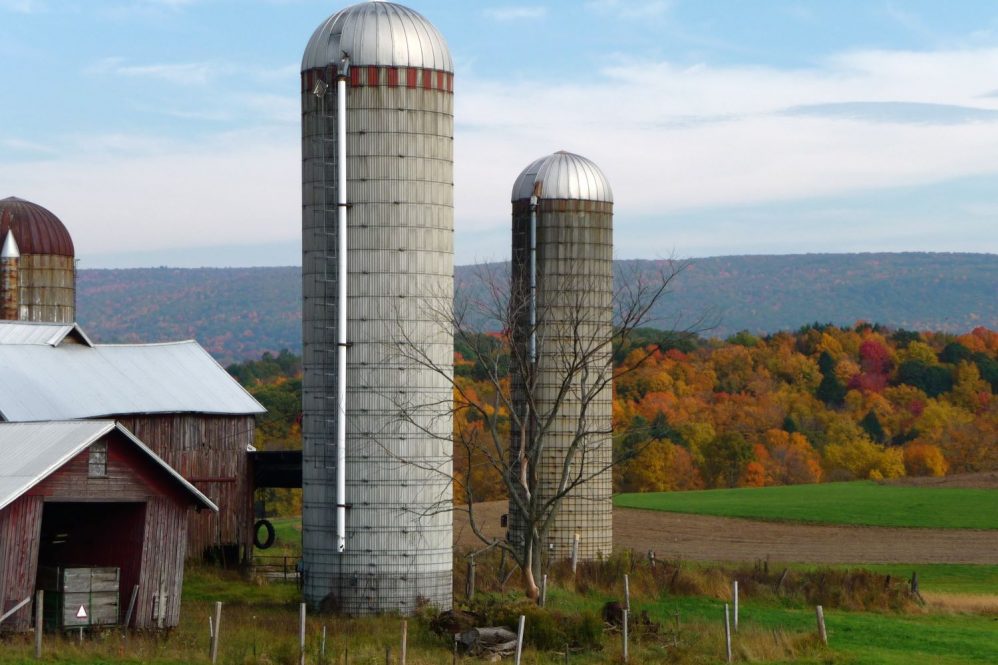Charles Towe, associate professor of agricultural and resource economics in the College of Agriculture, Health and Natural Resources, started noticing a change in land use in Columbia County, New York where his family farms.
Towe saw a lot of potential agricultural land in New York state going unused. He also personally knew farmers who couldn’t find land in their area. This led him to explore this trend of decreased agricultural productivity.
“I was trying to solve the problem of, how do we have hundreds and hundreds of acres of land idle, and farmers looking for land saying, ‘I can’t find any land around,’” Towe says.
Towe recently published his findings in Land Economics.
He found that of the 800 agricultural parcels in Columbia County, an area near the Catskill Mountains, about a quarter were owned by non-residents. Of the non-residents – people whose primary address is somewhere other than their property in Columbia County – the most significant population came from New York City, which is about two hours away by car.
While there may be non-resident owners from other areas, Towe focused his study on New Yorkers to understand their impact on land use in his community.
“It appears that there is a preference for the amenities that an ag parcel here provides for second homeowners coming out of the city,” Towe says.
Since 2001, nonresident ownership of farmland in Columbia County increased by 22.7%. Part of this upward trend may be related to the use value taxation credit New York state offers. The credit, which has existed for decades, allows property owners to receive a break on their property taxes if they use part of their land for agricultural purposes.
However, there are few stipulations about what this use must look like. While the credit does benefit farmers, many non-resident owners use part of their land to produce low-value hay for animal bedding, but not a lot else. Others may rent out their land to local farmers as a way to receive the credit.
Looking at two USDA databases on land use records from the past decade, Towe found that when non-residents buy agricultural land in this area, 10-11% of the land is removed from the agricultural sector altogether. An additional 10-11% is used for low-value hay.
In 2019, Towe completed a similar study for the Connecticut Department of Agriculture to evaluate Connecticut’s Public Act 490 which provides tax breaks for agricultural land. The Act was adopted in 1963 to help preserve the state’s farm, forest, and open land.
Just like in New York, Towe found that, by far, the most common crop grown on farmlands that the owner rented out was hay, around 40%.
“At the end of the day, if you want to buy land and use it in your way, that’s your right,” Towe says. “But perhaps certain pro-agricultural tax policies should be revisited to verify that these are not being abused.”
Towe says this is the “first log on the stack” of uncovering the questions surrounding land use change with non-resident owners and the costs and benefits to the local community.
“There’s a lot happening here that’s kind of hard to put a finger on,” Towe says.
The next study Towe is conducting will look at data from short-terms vacation rentals in the area. Local attitudes often see these types of rentals as detrimental to the local community. But the full picture is likely more complicated as additional rental income makes more expensive homes more affordable to residents, and they bring tourist spending to the area.
“We’re trying to make an economic link between the urban and rural communities because the country feels like it needs it,” Towe says. “I think the takeaway from this is we’re really trying to say, ‘What are the impacts, what are the positives and negatives of being in this second home market.'”
This work relates to CAHNR’s Strategic Vision area focused on Fostering Sustainable Landscapes at the Urban-Rural Interface.
Follow UConn CAHNR on social media



